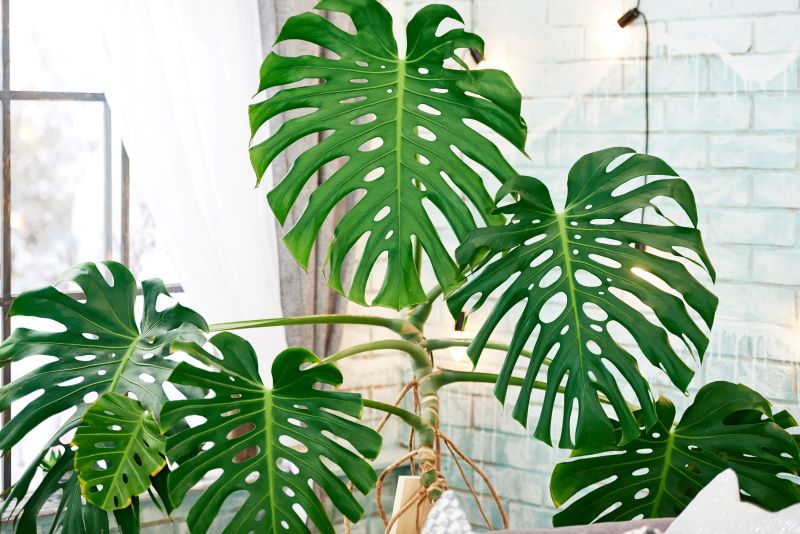While the plant might have a scary name, Monstera propagation shouldn’t scare you at all. This easy-going tropical plant makes a great houseplant, and once you know how to propagate and care for it, your home will soon be swarming with friendly monsters.
Monstera deliciosa, also known as the Swiss Cheese Plant, is a stunning plant that has become well-known and featured in art and fashion. Coming from the tropics of Central America, this plant features broad leaves with distinctive natural holes. Scientists have theorized that the holes help maximize the leaf’s surface area, which allows it to capture more sunlight from the floor of the rainforest. Another theory is that it allows rain to pass through the leaf, limiting damage. Whatever the reason for the holes, they give the plant a very distinctive, stunning look that will warm up any room.

Monstera deliciosa in Latin means “monstrous” (the deliciosa part refers to the edible fruit that it grows when planted outdoors), and this name is appropriate as this plant can grow rapidly up to dozens of feet high, and its leaves can grow up to three feet wide. While it can cost a bit to buy a Monstera plant, with this guide on how to propagate Monstera you can fill your home with new baby Monsteras for free!
Monstera propagation is easy because of the plant’s rapid growth and resilience, and it’s good for the plant. When your Monstera starts growing too much in one direction, or looks lopsided, or is just too tall to support itself, it’s helpful to the plant to prune some of the excess growth. The best time to propagate is in the spring or summer, as the plant goes into hibernation in the winter, and we don’t want to disturb it then. It’s easy to tell when Monstera is ready for propagation. First, it will get monstrous and spread all over the place. Second, you’ll see roots start growing from the stems. These ariel roots are very important in Monstera deliciosa propagation.
How to Progagate Monstera
Monstera Propagation Method 1: Rooting Method
- It’s important not to transfer bacteria to your plant, so first clean your cutting shears with rubbing alcohol, or rinse with boiling water.
- Don’t just cut your Monstera at random. Always cut below an ariel root or leaf node. Ariel roots are generally long and silver-gray in color, and leaf nodes are the beginnings of ariel roots, and look like plant pimples.
- Snip the stem below the ariel root or node. Cut at an angle so the stem can absorb the most amount of water. Remove any extra leaves from the cutting, leaving only two or three.
- Fill a glass jar or vase halfway with room temperature filtered water. Position the cutting in the glass so it remains upright. Use twist ties or string to help keep it upright, or use a jar with a narrow opening.
- Leave the jar in a spot out of direct sunlight, and watch as the roots start to grow! It should take a few weeks for the first shoots to appear. Once there are a lot of pale-colored roots, it’s time to pot your Monstera. This won’t happen overnight; Monstera propagation is a slow process, but the results are worth it!
Monstera Propagation Method 2: Air Layer
- For this method you’ll need sphagnum moss (undyed), plastic wrap, and twist ties or wire.
- Make an incision on the stem below a node. Be careful not to cut all the way through the stem.
- Moisten the sphagnum moss and wrap it around the node and incision. Wrap plastic wrap around the moss and secure it with twist ties or wire.
- Every few days, unwrap the plastic and moisten the moss with a spray bottle. After a few months you will see roots growing from the node.

- When your roots are big enough, cut the stem off where you made the incision and pot your new Monstera Propagation!
How to pot your Monstera deliciosa after propagation
Once your Monstera propagation has enough roots, it’s time to pot it. Choose a well-draining pot, and fill with soil. You can add some compost or a little bit of liquid fertilizer to help your plant flourish.
A great plant for passing on! Start with your own and by following our easy Monstera propagation guide you’ll soon be sharing with others.
Monstera Deliciosa Care
Now that you’ve learned how to propagate Monstera, it’s time to learn how to keep your new little monster alive!
Sun
Monstera plants grow naturally underneath a canopy of trees, so they like bright to medium indirect light. You can get the filtered light effect by placing them near a window covered in sheer curtains. On the other hand, if your Monstera doesn’t get enough light, it won’t grow any holes.
Water
Water your plant every 1-2 weeks, allowing the soil to dry out between waterings. The best water for your plant is filtered water, or tap water that you’ve left out overnight.
Humidity
Monstera prefers humid conditions, but it will be fine in normal home conditions. If you notice that it needs more humidity, you can turn on a humidifier, or place a tray filled with water and pebbles near your plant. Mist the leaves occasionally.
Fertilizer
Use a liquid fertilizer monthly in the summer when your plant is actively growing.
Temperature
The ideal temperatures for your Monstera plant are 65°F – 85°F (18°C – 30°C). Try not to let the temperature go below 60°F (15°C).

Potting
To keep your Monstera from growing too big, avoid repotting it too often. Your plant will benefit from some sort of support such as a small trellis or poles, since it is a climber in its natural habitat. This will also help keep it from sprawling too much.
Toxicity
The Monstera will irritate dogs, cats, and humans if it is ingested. It can irritate mouth, lips, and tongue, and can cause drooling, vomiting, and difficulty swallowing.
Problems
Leaves turning brown at the edges
Your plant is probably thirsty! Check the soil and give it water as needed. Another cause could be salt buildup, so if you suspect this to be the case, take it outside and leach it by watering it thoroughly several times.
Wilting
Your plant is probably thirsty, or it’s too big for its pot. Check the soil first, and if that’s not the problem, check the roots to see if you need a bigger pot.

Leaves turning yellow/stems turning black
This is most likely happening because you are overwatering. Allow it to dry out completely before watering again.
If you’re looking to add some splendor and elegance to your home, Monstera deliciosa is an excellent choice! Guest will be in awe at your stunning Monstera. The best thing about this plant is that if you want to fill your home with it, you don’t need to go out and buy ten more, since you can easily propagate your own with this guide on how to propagate Monstera. By following all of the steps above and with a little patience, you’ll soon be an expert at Monstera propagation!




